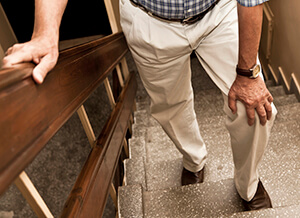10 home hazards that can threaten one’s fall risk
The first day of fall is National Fall Prevention Awareness Day. STEADI stands for Stopping Elderly Accidents, Deaths & Injuries. It is an initiative to help everyone recognize the danger falls pose for older adults and to help prevent them.
Among the ways older adults can limit their fall risk include working with a health care provider to manage their health, maintaining good balance and identifying everyday hazards that can make falls more likely at home.
Among the common problem spots that STEADI has identified include the following:
Stairs and Steps
- Are they free of clutter? Too often we place items on stairs as a reminder to grab those items on our next trip up those stairs. These items can pose a major fall risk for those unaware of them, or if we have forgotten about those items.
- Is there adequate lighting and visibility of each step? Dark stairways are a risk in the event we trip or miss a step going up or down because we did not see it. Fixing, replacing, or installing additional lighting is a great plan. Affordable and easy options to install more lighting is available and includes stick-on sensor lights and light strips.
- Are there sturdy handrails to use? Loose handrails should be repaired or replaced. If possible, handrails are best on both sides of the stairs and extending the full length of that stairway.
- Whether indoors or outdoors, are steps in good condition? Ensuring that steps are not broken or uneven can minimize our risk of falling and offer stable footing where we need it.
Bedrooms
- Is there a clear, well lit pathway from your bed to bathroom? Using nightlights or placing a flashlight on the nightstand can minimize our risk of falls as our eyes need to adjust to the light difference from day to night. Nightlights and small flashlights are great to bring with while on vacation or staying with family.
- Is there a lamp within reach of the bed? Having a light accessible as we prepare for bedtime and get settled in is important to prevent navigating in the dark.
Kitchen
- Are the items we use most within reach? Kitchen gadgets or tools that we use only sporadically are best placed in those far corners or higher cabinets leaving space for the items we use often within reach.
- Is a sturdy step-stool with hand bar available? Purchasing a stool that has a wide base, large steps with non-slip footing and a handrail allows us a much safer option to reach those items just out of reach.
Bathroom
- Bathtubs and showers by nature can be slippery. Is there safe footing in yours? Placing non-slip, self-stick strips are easy and a great method of keeping our feet where they should with better grip. Be wary of non-slip mats that have suction cups as they can lose their suction over time with the consistent moisture they are exposed to.
- Do you need assistance getting in or out of the shower/tub or on and off the toilet? Installing grab bars next to the toilet and shower and inside the shower help with the extra stability we need. Resources are available to help install grab bars. Be cautious of suction-cup grab bars as they can lose their grip over time; if you have a suction-cup grab bar, check the grip with a light tug before using it for your full body weight.
